Have you ever felt a sharp, nagging pain in the side of your hip, making even simple tasks like climbing stairs or standing on one leg feel like an Olympic challenge? Welcome to the world of gluteus medius discomfort—a pain that’s all too real for many. While it may feel like you’re navigating an endless cycle of stiffness and soreness, there’s hope. With the right knowledge and targeted exercises, you can actively combat this discomfort and reclaim your mobility. Dive into our guide to understand your pain better and discover easy, effective ways to soothe and strengthen your gluteus medius.
Contents
The Gluteus Medius: Anatomy, Function, and Its Role in Hip Movement
 At first glance, the hip might seem like a simple joint. However, beneath the surface, it’s a complex interplay of muscles, tendons, and ligaments, all working in harmony to provide stability and movement. It’s a thick and fan-shaped muscle, nestled right beneath its more famous counterpart, the gluteus maximus.
At first glance, the hip might seem like a simple joint. However, beneath the surface, it’s a complex interplay of muscles, tendons, and ligaments, all working in harmony to provide stability and movement. It’s a thick and fan-shaped muscle, nestled right beneath its more famous counterpart, the gluteus maximus.
The gluteus medius muscle is situated on the outer surface of the pelvis. It runs from the ilium (the broad, flared portion of the pelvic bone) and tapers down to attach at the top of the femur, which is the thigh bone.
Vital Functions of Gluteus Medius Muscle
- Hip Abduction: This is the primary function of the gluteus medius. It means moving the leg away from the midline of the body. Think of standing on one leg—the gluteus medius of the standing leg is hard at work ensuring you don’t topple over.
- Pelvic Stabilization: When you walk, run, or even stand on one leg, your pelvis needs to remain level. The gluteus medius ensures that the opposite side of the pelvis doesn’t droop, maintaining a balanced posture.
- Internal and External Rotation: Apart from lifting the leg sideways, the gluteus medius also aids in rotating the hip inwards and outwards. This function is crucial for motions like turning on your heels or adjusting the direction of your foot while walking on uneven terrains.
In essence, this hip joint is one of the most used and weight-bearing joints in our body. The gluteus medius, given its pivotal position and function, ensures that the forces exerted on the hip are evenly distributed.
What Causes Discomfort In The Gluteus Medius?
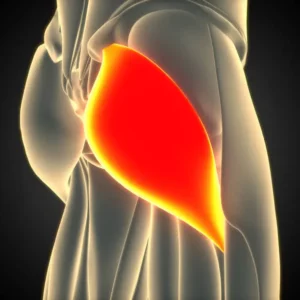 The gluteus medius, while a robust muscle, is not immune to strain and injury. Let’s dive into some common causes that can contribute to pain in this crucial hip stabilizer:
The gluteus medius, while a robust muscle, is not immune to strain and injury. Let’s dive into some common causes that can contribute to pain in this crucial hip stabilizer:
- Overuse Injuries: Any repetitive motion, especially in sports like running or cycling, can result in overuse of the gluteus medius. Over time, this consistent strain without adequate rest or counter-training can lead to inflammation or even small tears in the muscle fibers.
- Weakness in Surrounding Muscles: If the surrounding muscles, like the gluteus maximus or the hip flexors, are weak or imbalanced, the gluteus medius has to work harder to stabilize the pelvis, leading to strain and discomfort.
- Improper Training Techniques: Engaging in sports or exercises without proper form or technique can place undue stress on the gluteus medius. For instance, improper foot alignment while running or incorrect posture during squats can overload this muscle.
- Tendinitis: The tendon of the gluteus medius can become inflamed due to repetitive motions, which is a condition called tendinitis. This can cause sharp pain in the hip area, especially during movement.
- Bursitis: Right next to the gluteus medius is a small fluid-filled sac called the trochanteric bursa. Inflammation of this bursa, known as trochanteric bursitis, can mimic the symptoms of gluteus medius pain.
- Underlying Medical Conditions: Certain conditions like hip labral tears, osteoarthritis, or even lumbar spine issues can refer pain to the hip region, sometimes confusing it with gluteus medius pain.
- Postural Issues: Chronic poor posture, such as an exaggerated curve in the lower back, can place added strain on the gluteus medius as it tries to stabilize and balance the pelvis.
By recognizing potential pitfalls, one can take preemptive measures to avoid injury or seek appropriate interventions when pain arises.
Effective Stretches for Immediate Relief from Gluteus Medius Pain
The gluteus medius is vital for various movements and plays a critical role in stabilizing our hips. Therefore, keeping it flexible and pain-free is essential. The following stretches can help alleviate discomfort in the gluteus medius, promoting better hip function and overall mobility. Remember, visual aids or videos demonstrating these stretches can be incredibly beneficial for ensuring proper form.
Standing Hip Stretch
- How to do it:
- Stand upright and cross your right ankle over your left knee, creating a figure-4 shape.
- Bend your left knee slightly, pushing your hips back as if you’re about to sit in a chair.
- Push gently down on the right knee with your right hand while keeping your spine straight.
- Hold the position for 20-30 seconds, feeling a stretch in your right hip.
- Repeat on the other side.
Lying Hip Rotation Stretch
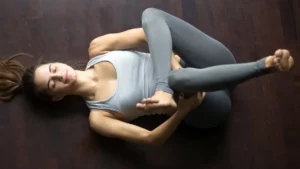
- How to do it:
- Lie on your back with your knees bent and feet flat on the ground.
- Cross your right ankle over your left knee.
- Grab your left thigh with both hands and pull it gently towards your chest.
- Hold the stretch for 20-30 seconds, feeling the stretch in your right gluteus medius.
- Repeat on the other side.
Clamshell Stretch
- How to do it:
- Lie on your side with your hips and knees bent at a 90-degree angle.
- Keeping your feet together, lift your upper knee as high as possible without moving your pelvis.
- Hold the position for a few seconds before lowering the knee.
- Perform 10-15 repetitions, then switch to the other side.
Seated Hip Stretch
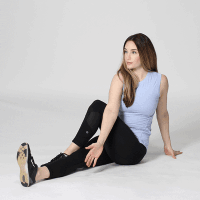
- How to do it:
- Sit on the ground with your legs extended in front of you.
- Bend your right knee and cross it over the left leg, placing your right foot flat on the ground near the left knee.
- Rotate your upper body to the right, placing your right hand on the ground for support.
- Use your left arm to push gently against your right knee, deepening the stretch.
- Hold for 20-30 seconds and then switch sides.
Remember, stretching should never cause sharp or severe pain. It’s always crucial to listen to your body and perform these stretches within a comfortable range.
Building Strength to Prevent Future Pain
The gluteus medius muscle, though not as famed as its counterpart the gluteus maximus, plays a pivotal role in hip stabilization, especially during single-leg activities like walking, running, and standing on one leg. Strengthening the gluteus medius and the surrounding hip muscles not only offers relief from current discomfort but also lays a foundation to prevent future pain. Here are some effective exercises to consider:
Side-Lying Leg Raises
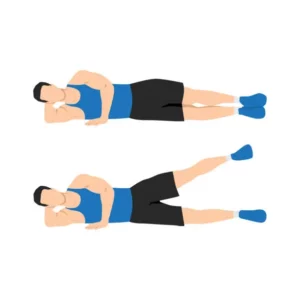
- How to do it:
- Lie on your side with your legs extended straight.
- Ensure your hips are stacked vertically and your head rests on your arm or a pillow.
- Keeping your foot flexed, lift the top leg to about 45 degrees and then lower it slowly.
- Perform 10-15 repetitions on each side.
Standing Hip Abduction
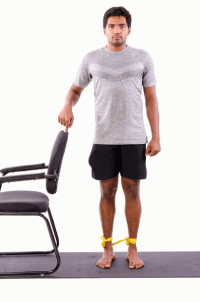
- How to do it:
- Stand upright next to a wall or a sturdy object for balance.
- Keeping your toes pointing forward, lift one leg out to the side without leaning into the opposite hip.
- Lower the leg back down with control.
- Complete 10-15 reps on each side.
Clamshells with Resistance Band
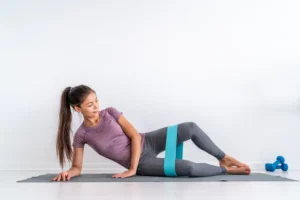
- How to do it:
- Place a resistance band around your thighs just above the knees.
- Lie on your side with your legs at a 90-degree angle.
- Keeping your feet together, raise your top knee as high as possible against the resistance of the band.
- Lower with control and repeat for 10-15 reps on each side.
Single Leg Bridge
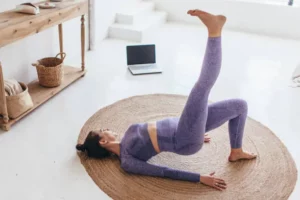
- How to do it:
- Lie on your back with your knees bent and feet flat on the ground.
- Extend one leg straight while pushing through the heel of the other foot.
- Lift your hips off the ground, squeezing the glutes at the top.
- Lower your hips back down and repeat for 10-12 reps before switching legs.
Fire Hydrants
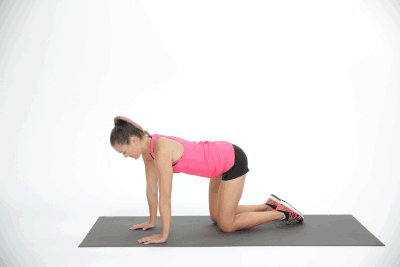
- How to do it:
- Start on all fours in a tabletop position.
- Keeping the knee bent, lift one leg out to the side like a dog at a hydrant.
- Return to the starting position and complete 10-15 reps on each side.
Consistency is key when it comes to strength training. It’s recommended to incorporate these exercises into your regular fitness routine for best results. As with all exercises, maintaining proper form is crucial to prevent injury and ensure maximum benefit. If unsure, seeking guidance from a fitness professional or physical therapist can be invaluable.
When to Seek Expert Intervention
While mild gluteus medius discomfort can often be addressed with home exercises and stretches, persistent or escalating pain should never be ignored. If the pain persists despite consistent self-care, hampers daily activities, or is accompanied by swelling, bruising, or a noticeable limp, it’s crucial to seek expert advice. Early intervention can prevent more severe complications and expedite recovery.
Professional treatments such as physical therapy sessions can offer specialized exercises and manual techniques tailored to individual needs. Additionally, massage therapies can relax tightened muscles, and other interventions like dry needling or ultrasound therapy might be suggested based on the severity and nature of the pain. Always prioritize your health and consult with a specialist when in doubt.
Conclusion
Navigating the complexities of gluteus medius pain can be challenging, but understanding its anatomy, causes, and potential remedies is half the battle. Ensuring you’re equipped with the right stretches and strength-building exercises is a proactive step towards better hip health. Remember, our bodies often communicate with us through pain, signaling when something is amiss. So, if you’re experiencing hip pain and believe that the gluteus medius is at the heart of your discomfort, don’t hesitate. Professional guidance can offer you the tailored support and techniques you need. Physical therapy for hip pain at PhysioMantra can be your solution. Book an online physical therapy session today and take a step towards a pain-free life.



